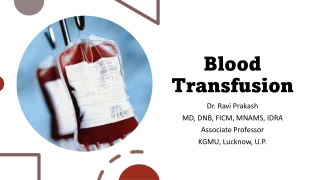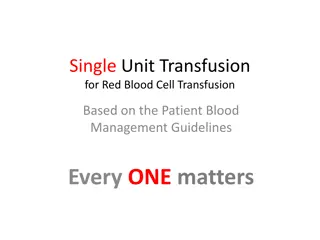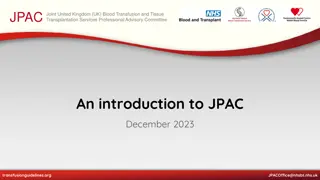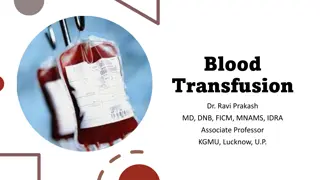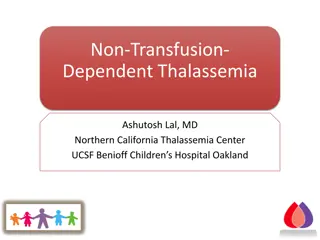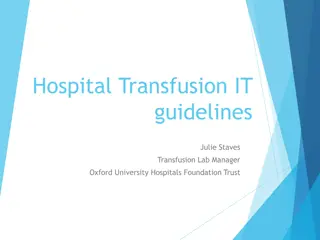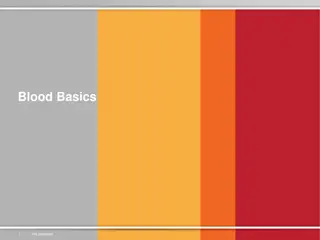Autologous Blood Transfusion Procedures and Usage
An autologous blood transfusion is a safe alternative to allogeneic transfusions, involving the collection and reinfusion of a patient's own blood for various surgical procedures. There are four types of autologous blood transfusion procedures, each serving specific advantages and applications, recommended based on the type of surgery and patient's concerns.
Download Presentation

Please find below an Image/Link to download the presentation.
The content on the website is provided AS IS for your information and personal use only. It may not be sold, licensed, or shared on other websites without obtaining consent from the author.If you encounter any issues during the download, it is possible that the publisher has removed the file from their server.
You are allowed to download the files provided on this website for personal or commercial use, subject to the condition that they are used lawfully. All files are the property of their respective owners.
The content on the website is provided AS IS for your information and personal use only. It may not be sold, licensed, or shared on other websites without obtaining consent from the author.
E N D
Presentation Transcript
AUTOLOGOUS BLOOD TRANSFUSION Dr Versha Prasad
AUTOLOGOUS BLOOD TRANSFUSION An autologous blood donation is when a person donates blood for their own use before or during a scheduled surgery. When the blood is given back, it is called an autologous blood transfusion. This is in contrast to an allogeneic blood transfusion, in which blood from another person is used. The primary reasons for an autologous transfusion are to reduce the risk of acquiring a blood borne infection or to ensure an ample supply of blood for yourself if blood resources are scarce. Autologous transfusion is the reinfusion of a patient's own blood. Increased awareness of the risks of homologous transfusion, primarily transfusion transmitted infections has caused patients and physicians to search for safer alternatives. One promising alternative is autologous transfusion, generally accepted as the safest form of transfusion.
AUTOLOGOUS BLOOD TRANSFUSION: TYPES There are four types of autologous blood transfusion procedures. Each has its advantages and disadvantages. They include: 1. blood is collected weeks before surgery. It is then stored in a blood bank and transfused back to the donor when needed. Preoperative autologous donation (PAD) is a procedure in which 2. blood right after anesthesia is given for surgery. Then, the same amount of replacement fluid is transfused back into the body to maintain normal blood volumes and blood pressure. Acute normovolemic hemodilution (ANH) involves the removal of
AUTOLOGOUS BLOOD TRANSFUSION: TYPES 3. surgery is immediately returned into circulation using a cell saver machine. The machine not only filters debris from the blood but adds an anticoagulant to keep it from clotting. Intraoperative cell salvage is a technique in which blood lost during 4. surgery via wound drains. The blood is treated in the same way as an intraoperative cell salvage but is reinfused after the surgery rather than during. Postoperative cell salvage involves the collection of blood lost during
WHEN IT'S USED: RECOMMENDED USE Clinician may recommend autologous blood transfusion based on the type of surgery you are undergoing. Other times, people concerned about blood transfusion risks, such as blood borne infections, allergy, or an autoimmune response, may request it as an elective procedure. If there is a possibility that you will need a blood transfusion during or after surgery, your surgeon may recommend an autologous blood donation before surgery. Cell salvage transfusions can also be done in an emergency. This is especially true for surgeries in which blood loss can be massive, such as surgery to resection the lung or liver in people with cancer. It is not uncommon for a person to need as many as 10 units of packed red blood cells in cases like these.
WHEN IT'S USED: RECOMMENDED USE An autologous donation can be used in addition to allogeneic donations to relieve pressure on the community's blood supply. Autologous blood transfusions are generally considered when your doctor anticipates that you may lose 20% or more of your blood during surgery. In addition to major cancer surgeries, autologous blood transfusions are often needed for major joint replacement surgeries, vascular surgeries, or cardiothoracic surgeries. Most people can generally avoid preoperative autologous donations if less than 10% of blood is expected to be lost during surgery.
AUTOLOGOUS BLOOD TRANSFUSION: ELECTIVE USE 1. Autologous transfusions may also be used as an elective procedure for people concerned about getting a blood borne infection like hepatitis B or HIV. 2. Autologous blood transfusions can also mitigate the risk of an allergic or autoimmune response that can occur on rare occasions with allogeneic transfusions. This includes hemolytic transfusion reactions in which the immune system attacks and destroys donated blood cells.
ADVANTAGES AND DISADVANTAGES Despite the benefits of an autologous blood transfusion, both real and perceived, they are not without their risks. From a larger perspective, there are pros and cons to undergoing the procedure ADVANTAGES Reduced risk of blood borne infections 1. 2. Reduced risk of allergic or hemolytic transfusion reaction 3. Safer in people with rare blood types 4. Safer in people with multiple autoimmune disorders 5. Reduces the demands on the community blood supply
ADVANTAGES AND DISADVANTAGES DISADVANTAGES 1. More costly than an allogeneic blood transfusion 2. Risk of an unnecessary blood transfusion 3. Unused blood is wasted 4. Risk of anemia and cardiac complications following the donation 5. Risk of bacterial infection due to improper storage of blood 6. from the body. May increase the need for a transfusion due to the depletion of blood
RISKS AND COMPLICATIONS: Preoperative Donations The risk of a preoperative autologous donation is no different than that of any other blood donation. However, with that said, since you are undergoing surgery, some medical conditions are contraindicated for blood donations. Preoperative autologous donations are not used in people with current heart disease and other conditions for which the transfusion may pose risks. These include. 1. Active seizure disorders 2. Heart attack or stroke within six months 3. Left-side coronary artery disease (high-grade) 4. Sepsis or bacteremia 5. Scheduled aortic aneurysm surgery 6. Symptomatic heart failure 7. Uncontrolled hypertension 8. Unstable angina
RISKS AND COMPLICATIONS Cell Salvage With intraoperative or postoperative cell salvage, the retrieved blood can undergo significant changes when washed in preparation for the reinfusion. The electrolyte imbalance, platelet loss, and hemoglobin released from red blood cells can trigger a serious condition called salvaged blood syndrome, in which clots form abnormally in blood vessels. Salvaged blood syndrome can lead to severe lung injury and acute renal failure when the lungs or kidneys are involved.
AUTOLOGOUS BLOOD TRANSFUSION Acute Normovolemic Hemodilution With acute normovolemic hemodilution, the sudden reduction in the volume of red blood cells (referred to as hematocrit) may lead to circulatory shock and even a heart attack in people with underlying heart disease. Currently, the effectiveness of acute normovolemic hemodilution compared to other types of autologous transfusions is uncertain. However, it is considered safe if hematocrit levels stay at 30% or more.
AUTOLOGOUS BLOOD TRANSFUSION: PROTOCOLS If you elect to undergo an autologous blood transfusion, a clinician will generally draw your blood preoperatively. There are no age or weight limits to an autologous transfusion. However, you should weigh the risks carefully to ensure that you are a good candidate for the procedure. Screening Upon arrival, a brief medical history is taken. In addition, a clinician will take your pulse, blood pressure, and temperature. Finally, they will perform a fingerstick blood test to check your hematocrit and determine if you are anemic.
AUTOLOGOUS BLOOD TRANSFUSION Donation Amount The amount you are allowed to donate is based on your weight. The maximum donation is calculated at 10 milliliters per kilograms of body weight (mL/kg). So, for example, a person who weighs 110 pounds (50 kg) can donate up to 500 milliliters (0.5 liters) per session.
AUTOLOGOUS BLOOD TRANSFUSION Frequency You can donate more than once a week, but the last should occur not less than 72 hours before your surgery. This allows time for your blood volume to return to normal. Blood can be refrigerated for no more than 42 days. After that time period, the blood bank will dispose of it. Blood banks can freeze blood, but it is not advised for autologous donations because freezing can damage blood cells and alter the composition of the blood. -----------------------------


